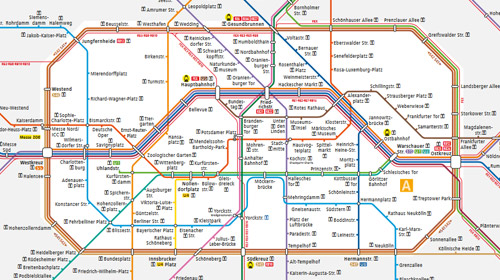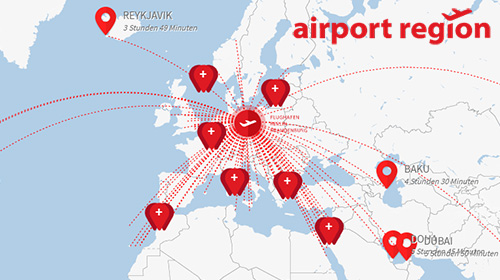Infrastructure
The capital connects Western and Eastern Europe. It is the intersection of European transport routes for the largest economic region in the Western world.
In motion
Trans-European transport routes on roads, rails, in the air or on water intersect in the capital area. Berlin meets the challenges of a growing metropolis with an increasing population and increasing flows of goods in passenger and freight transport with an efficient public transport network and efficient freight transport centers.
Berlin is very well connected nationally and internationally by train. Many large European economic centers such as Amsterdam, Rotterdam, Prague, Warsaw and Vienna can be reached quickly via Berlin Central Station. Direct connections lead to Paris in eight hours, to Munich and Frankfurt in four hours, to Hamburg in under two hours and to Stuttgart in five and a half hours.
Numerous cities in Brandenburg, such as Magdeburg, as well as the diverse natural landscapes and recreational areas of Brandenburg, are regularly connected to the capital by regional express lines.
(Sources: Senate Department for Urban Mobility, Transport, Climate Action and the Environment; Verkehrsverbund Berlin-Brandenburg; Flughafen Berlin Brandenburg GmbH, 2025)
Guaranteed supply
The capital region can rely on a high-performance infrastructure in the areas of energy, supply and disposal. Companies benefit from developments in innovative and sustainable technologies. The basic supplier of electricity in Berlin is Vattenfall, and GASAG AG ensures the basic supply of gas. As a grid operator and electricity supplier, state-owned Stromnetz Berlin GmbH is responsible for Berlin’s electricity distribution network. Energy-intensive companies with high electricity requirements can participate in Stromnetz Berlin’s new allocation or repartitioning procedure for grid connection capacities greater than 3.5 megavolt amperes (MVA). Furthermore, requests for grid connections with an output of less than 3.5 MVA can also be made there.
Electricity, gas and heating supply
- With a mix of energy sources from wind and hydropower, solar energy, biomass, natural gas and coal, the electricity supply companies in Berlin are actively contributing to the energy transition.
- Climate protection partnerships between energy suppliers and the State of Berlin are helping achieve the goals of climate neutrality by 2045 and the phase-out of coal by 2030 at the latest.
- With a length of around 2,000 kilometers, Berlin's district heating network is the largest in Western Europe and supplies around a third of Berlin's households with heat (as of 2024).
Water supply and wastewater disposal
- The drinking water supply and wastewater disposal for the approximately 3.7 million people in Berlin is guaranteed by Berliner Wasserbetriebe (BWB), one of the largest companies in this field in Germany.
- Berlin households, industry and commerce use an average of about 546,000 cubic meters of drinking water every day.
- The Berlin Rainwater Agency, which was founded by the State of Berlin and the BWB, advises on rainwater economy and rainwater management.
Berliner Stadtreinigung
- Berliner Stadtreinigungsbetriebe (BSR), Germany’s largest municipal cleaning company, ensures a clean city.
- BSR takes care of the waste from two million households and ensures clean streets, paths and squares all year round.
Recycling
- The ALBA Group offers disposal services for all types of waste and takes care of the efficient disposal of waste.
(Sources: Berliner Stadtreinigungsbetriebe, 2025; Berliner Wasserbetriebe, 2025; Senate Department for Economic Affairs, Energy and Public Enterprises, Wirtschafts- und Innovationsbericht 2023/2024)
Stable communication
Broadband
In order to promote nationwide gigabit broadband expansion, the State of Berlin has set up a gigabit competence team and adopted a gigabit strategy. This envisages a technology-open, nationwide gigabit supply by 2025 at the latest and a comprehensive fiber optic supply by the end of 2028. Currently, a stable, high-performance supply with a technology mix of FTTB/H, FTTC and HFC with download rates of up to 1,000 Mbit/s Berlin companies competitive.
In December 2024, Berlin had 40.8% fiber optic coverage and 95.7% gigabit coverage according to the Gigabit Monitor, the monitoring tool of the state of Berlin:
Mobile communications
The mobile network in the capital region is efficient and fast. 4G/LTE is available throughout Berlin. With 5G SA coverage of 99.97 percent (as of 04/2025), Berlin has an excellent 5G network and ranks second in Germany. With research projects such as 5G Berlin, Berlin is getting ready for the future.
(Source: Gigabit-Portal Berlin, 2025)
Consistent security
In Germany, the authorities and organizations with security tasks (BOS) include all organizations that perform internal emergency response tasks. In addition to police measures, this also includes assistance in the event of accidents and disasters.
With dedicated people from the Berlin fire department and the Berlin police, Berlin is meeting the challenges of a big city and making life in Berlin safer. With approx. 27,000 employees, the Berlin police force is the largest security authority in the State of Berlin. It works effectively with the Berlin fire department, the oldest and largest professional fire department in Germany (founded in 1851) with over 5,000 employees and 35 professional fire stations.
(Sources: Berlin Police; Berlin Fire Department, 2025)









